

Instacart Customer APP
Redesign the customer app

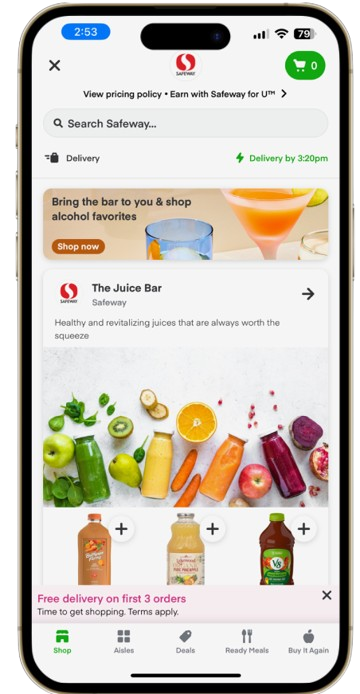


PRODUCT DESIGN
Create Problem Statement, User Flow Map, Low-Fidelity Map, Wireframing
UI DESIGN
User Interface Design, UI Elements, Hi-Fidelity Map, Prototyping
FIGMA
Wireframing, Prototyping, LO, MID, HI-FI Mapping, UI components
SLACK
Team collaboration
MURAL
Brainstorming, mapping
TEAMS
Interviews, Team meetings
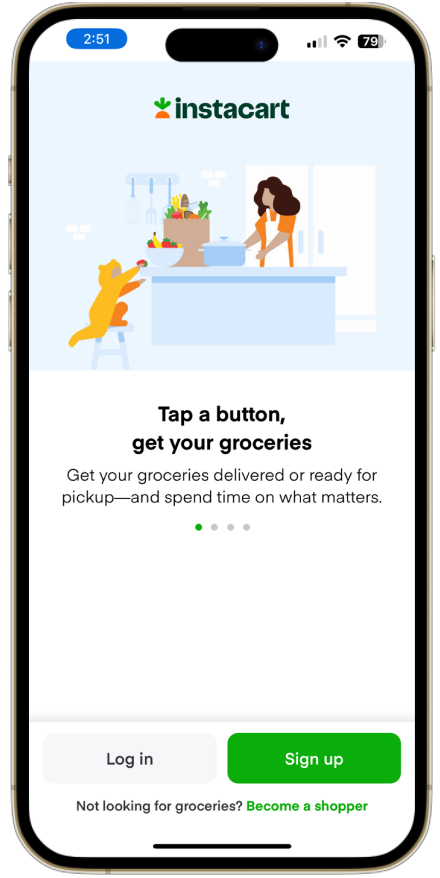
Introduction
Instacart is a popular grocery delivery and pickup service that has revolutionized the way people shop for groceries. As part of our commitment to delivering exceptional user experiences, we embarked on a UX/UI and Product Design project to enhance the Instacart Customer App. This comprehensive case study outlines our journey, methodologies, and the key outcomes of this project.

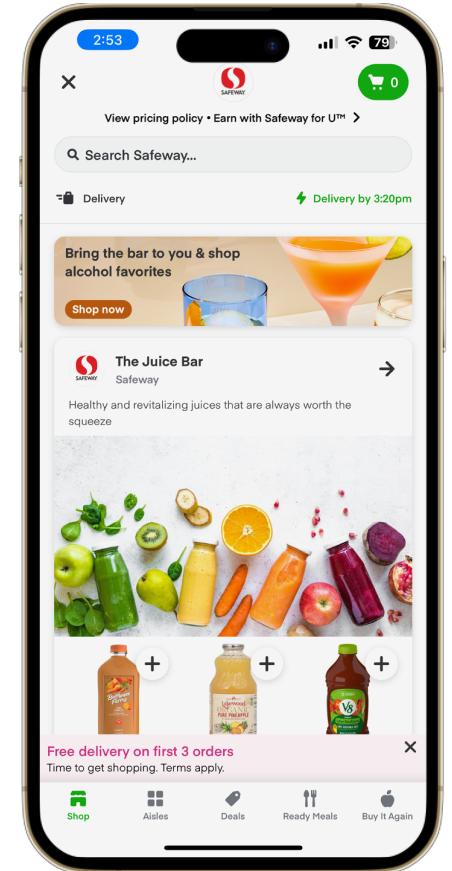

Project Goals
Our primary objectives for the Instacart Customer App redesign were as follows:
- Enhanced User Experience: Improve the overall user experience to make grocery shopping more convenient and enjoyable.
- User Interface Modernization: Redesign the user interface to ensure it aligns with modern design trends while maintaining brand identity.
- Efficiency and Accessibility: Streamline the shopping process, making it quicker and accessible to a broader range of users.
- Feature Expansion: Introduce new features and functionalities that provide value to users.
The Problem
The primary problem in the Instacart Customer App was the need for significant improvement in the user experience (UX) and user interface (UI) design. The existing app had several pain points and challenges that required attention:
- Usability Issues: Users found the app’s interface to be less intuitive and efficient. Navigating through the app and completing tasks, such as adding items to the cart and placing orders, was not as smooth as desired.
- Outdated UI: The user interface design did not align with modern design trends, potentially leading to a less engaging and visually appealing experience for users.
- Limited Features: The app lacked certain features that could enhance user engagement and convenience, such as personalized product recommendations and advanced search capabilities.
- Accessibility: Ensuring that the app was accessible to a broader range of users, including those with disabilities, was a challenge that needed to be addressed.
- Competitive Advantage: Instacart wanted to maintain a competitive edge in the grocery delivery industry by offering a superior app experience compared to competitors.
To address these issues, the project aimed to revamp the app’s UX/UI design, streamline the shopping process, introduce new features, and make the app more visually appealing while maintaining the brand’s identity. The comprehensive redesign aimed to provide a more efficient, engaging, and user-centric grocery shopping experience for Instacart’s customers.


User Research
We conducted in-depth user research to gain insights into our audience's behaviors, preferences, and pain points. Key findings included:
- Users appreciate a simplified, intuitive interface.
- Timely and accurate delivery is a top priority.
- Users seek personalized recommendations.
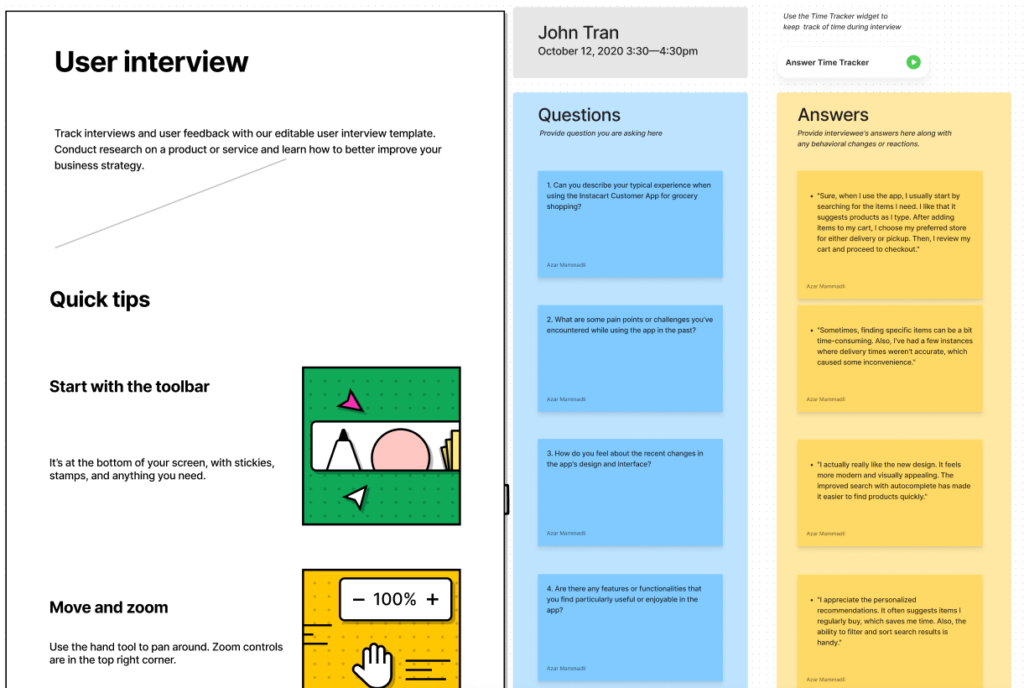
Competitive Analysis
We analyzed competitors’ apps to identify best practices and areas for differentiation. Insights from this analysis guided our design decisions.
Information Architecture
We revamped the app’s information architecture to ensure logical flow and organization of content. Key sections include:
- Home
- Search
- Cart
- Account
- Orders
- Discover
Wireframing and Prototyping
We created wireframes to visualize the app’s layout and functionality. Interactive prototypes were developed to test user interactions and gather feedback
UI Design
Our UI design focused on creating a clean, visually appealing, and user-centric interface. Key design elements include:
- A fresh color scheme that aligns with Instacart’s branding.
- User-friendly typography and iconography.
- High-quality product images and clear pricing information.
instacart customer app
Feature Enhancements
We introduced several new features:
- Personalized Recommendations: Utilizing machine learning algorithms to suggest products based on user preferences and purchase history.
- Deals in store: Allowing users to easily see the deals in the stores.
- Search stores by zip codes: Allows users to easily find and select stores based on their location. .
- Enhanced Search: Enhancing the search functionality in the Instacart Customer App to include products, stores, and recipes offers users a comprehensive and versatile search experience
Key Stages:
Awareness: The user becomes aware of the Instacart Customer App through advertising, recommendations, or word-of-mouth.
Onboarding: The user downloads and installs the app, creating an account or signing in.
Exploration: The user explores the app’s features, including browsing products, viewing store options, and searching for items.
Search and Discovery: The user initiates a search, looking for specific products, stores, or recipes. Autocomplete and predictive search assist in finding relevant results quickly.
Product Selection: After searching, the user selects products of interest and adds them to the cart. They may also explore product details, ratings, and reviews.
Store Selection: If the user intends to shop in-store, they use the store locator to find nearby grocery stores.
Recipe Discovery: For users interested in recipes, they search for meal ideas and recipes that match their criteria.
Filtering and Sorting: Users refine their search results using filters, sorting options, and dietary preferences, ensuring they find the most suitable items.
Checkout: Users review their cart, make adjustments, and proceed to checkout. They select delivery or pickup options based on their preferences.
Real-Time Tracking: If the user opts for delivery, they can track their order in real-time, receiving updates on delivery progress.
Order Confirmation: Users receive confirmation of their order, including estimated delivery times.
Repeat Usage: Satisfied with the experience, users are likely to return to the app for future grocery shopping needs.
Feedback and Reviews: Users have the option to provide feedback, rate products, or leave reviews, contributing to the app’s community.
Favorites and History: Users save favorite items, stores, and recipes, streamlining future shopping experiences.
Deals in stores
Adding a “Deals in Stores” feature to the Instacart Customer App was a significant enhancement that provided users with valuable information and opportunities to save on their grocery purchases. Here’s how this new feature benefits users:
1. Access to Exclusive Discounts: Customers can now easily browse and access exclusive deals and discounts available at their favorite stores within the app.
2. Convenience: Users no longer need to visit individual store websites or check physical flyers to find the latest deals. Everything is conveniently accessible in one place.
3. Personalization: The feature can be personalized based on the user’s location and shopping history, ensuring that they see deals that are relevant to their preferences and needs.
4. Real-Time Updates: Customers can view real-time updates on deals and promotions, ensuring that they never miss out on savings, even if they haven’t visited the physical store.
5. Better Shopping Experience: By providing access to deals, the app enhances the overall shopping experience, making it more enjoyable and cost-effective.
6. Informed Purchases: Customers can plan their shopping lists and purchases more effectively, taking advantage of discounts and special offers.
7. Increased Engagement: The addition of this feature encourages users to spend more time within the app, exploring deals, and potentially making additional purchases.
This feature aligns with Instacart’s goal of providing an enhanced user experience and demonstrates a commitment to meeting user needs while delivering value. It also positions Instacart as a one-stop solution for grocery shopping and savings, further strengthening its competitive advantage in the market.
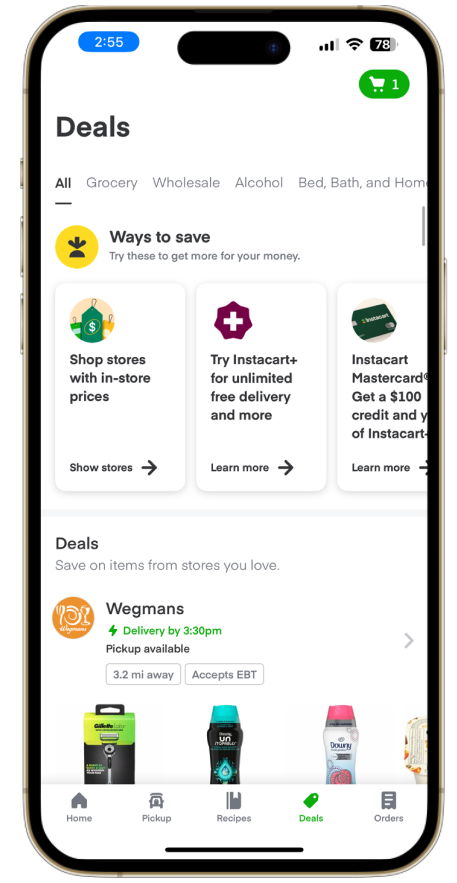

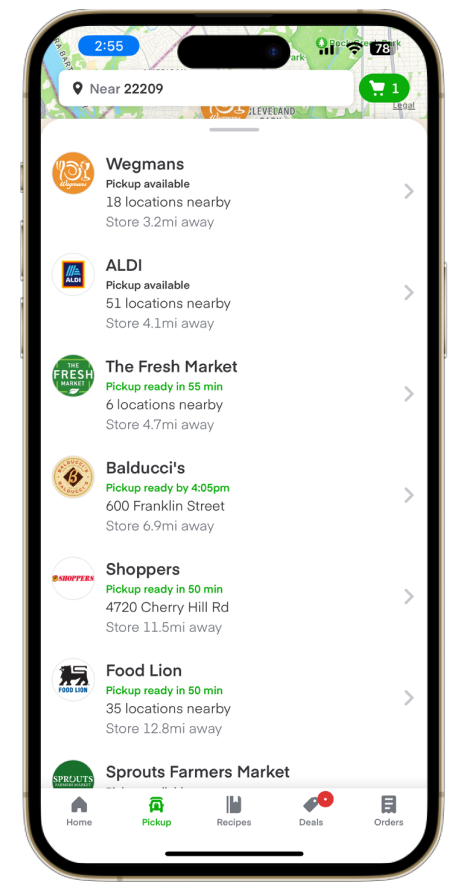

Search Stores by Zip Codes
Adding a “Search Stores by Zip Codes” feature to the Instacart Customer App is a valuable addition that enhances the user experience by allowing users to easily find and select stores based on their location. Here’s how this new feature benefits users:
1. Location Convenience: Users can input their zip code or allow the app to access their location, making it convenient to find nearby stores quickly.
2. Personalization: The feature can provide a list of stores tailored to the user’s specific location, ensuring that they see options that are relevant to them.
3. Time Efficiency: Users can save time by locating stores in their vicinity, reducing the need for manual searching or browsing through a long list of stores.
4. Accessibility: This feature is particularly helpful when users are in an unfamiliar area or traveling and need to find grocery stores nearby.
5. Targeted Shopping: Users can plan their shopping trips more efficiently, knowing the exact locations of the stores they want to visit.
6. Seamless Integration: The feature seamlessly integrates with the app’s existing functionalities, such as adding items to the cart and placing orders at the selected store.
7. Improved User Satisfaction: By simplifying the store selection process, the feature contributes to a more satisfying and user-friendly shopping experience.
8. Increased Engagement: Providing users with location-based store options encourages them to explore and engage with the app, potentially leading to more frequent usage.
Overall, the “Search Stores by Zip Codes” feature adds an extra layer of convenience and personalization to the Instacart Customer App, making it easier for users to find the grocery stores that best suit their needs based on their location.
Enhanced Search
Enhancing the search functionality in the Instacart Customer App to include products, stores, and recipes offers users a comprehensive and versatile search experience. Here’s how this enhancement benefits users:
1. Unified Search: Users can perform a single search query to find not only specific products but also nearby stores and relevant recipes. This streamlines the search process and reduces the need for separate searches.
2. Product Search: Users can search for specific grocery items, brands, or categories. The app provides autocomplete suggestions and predictive search to help users find products quickly and accurately.
3. Store Locator: Users looking for a nearby grocery store can enter their location or use the app’s GPS to find stores in their vicinity. This feature is particularly helpful when users are traveling or in an unfamiliar area.
4. Recipe Discovery: Users interested in cooking or meal planning can search for recipes based on ingredients, cuisine, dietary preferences, or cooking time. The app can suggest recipes based on available ingredients in the user’s cart or shopping history.
5. Filtering Options: Users can refine their search results based on product attributes, store features (e.g., curbside pickup, delivery), and recipe criteria (e.g., vegetarian, under 30 minutes). This ensures that users find the most relevant results.
6. Cross-Referencing: Users can seamlessly switch between product, store, and recipe search results within the same search session. This flexibility enables a more holistic shopping experience.
7. Visual Search: The app may include visual search capabilities, allowing users to take photos of products, store facades, or dishes, and the app can identify or provide information related to the image.
8. Favorites and History: Users can save their favorite products, stores, and recipes for quick access in future searches. Additionally, a search history feature allows users to revisit their recent searches.
By enhancing the search functionality to include products, stores, and recipes, the Instacart Customer App becomes a versatile tool for users, catering to their diverse needs in grocery shopping, store discovery, and meal planning. This comprehensive search feature enhances user engagement and satisfaction.

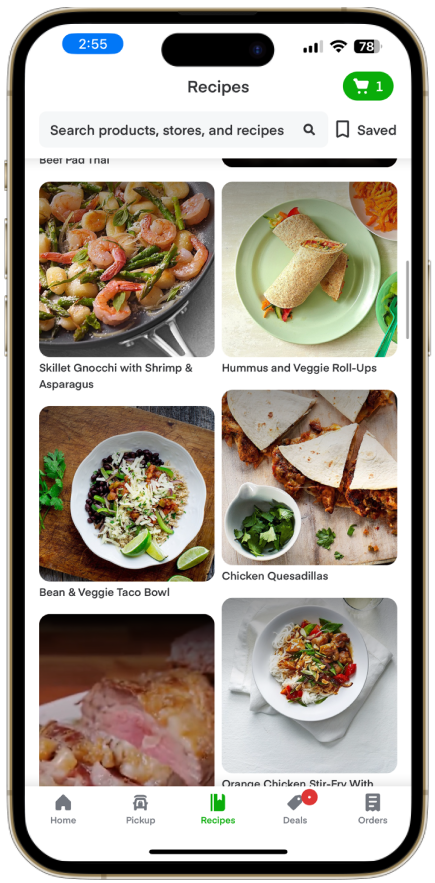
Hi-Fi Map
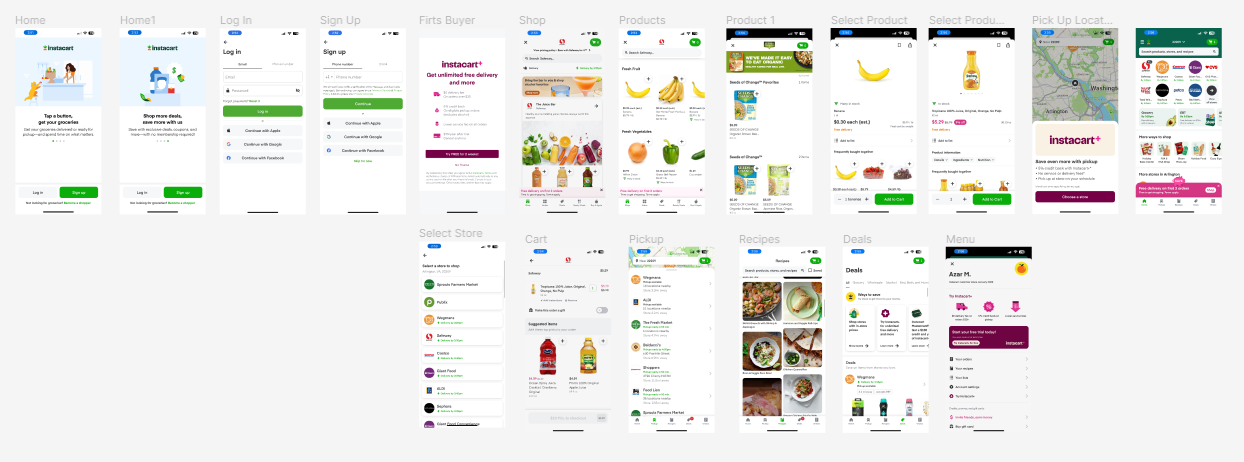
Testing, Results & Conclusion
Testing and Iteration
We conducted usability testing with a diverse group of users to identify pain points and gather feedback. Based on the feedback, we made iterative design improvements to enhance the app's usability and overall user experience.
Results
The redesigned Instacart Customer App has delivered substantial benefits: Increased User Satisfaction: User feedback indicates improved satisfaction with the app's ease of use and efficiency. Higher Engagement: Users are spending more time exploring the app, leading to increased order frequency. Boosted Conversion: The enhanced personalized recommendations feature has led to an uptick in users adding recommended items to their carts. Improved Accessibility: The app's streamlined design has made it more accessible to a wider range of users.
Conclusion
The Instacart Customer App UX/UI and Product Design project has successfully elevated the user experience, increased user engagement, and positively impacted Instacart's bottom line. Our commitment to user-centered design, rigorous testing, and continuous improvement has resulted in an app that not only meets user needs but also delights and exceeds their expectations. As we move forward, we will continue to refine and expand the app's features to provide an even more exceptional grocery shopping experience for Instacart's valued customers.
